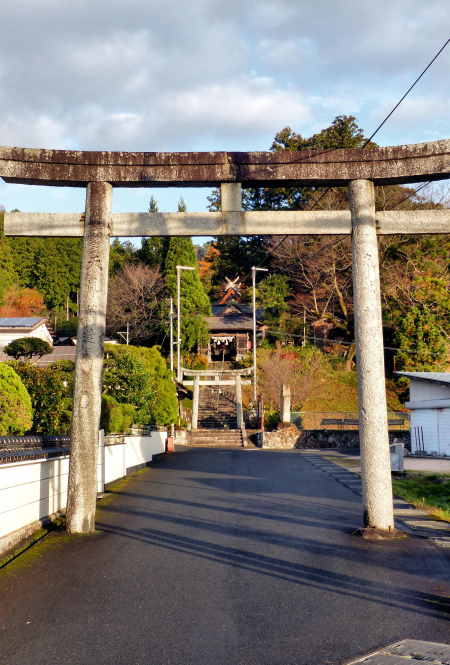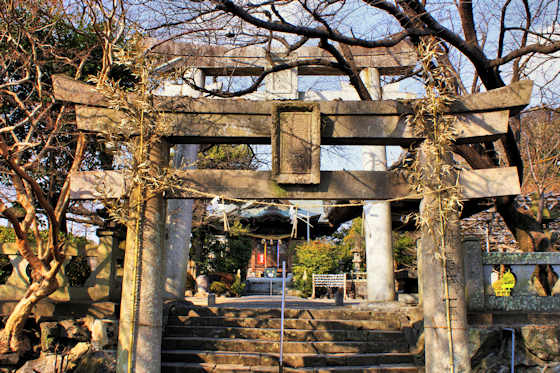Showing posts with label Susano. Show all posts
Showing posts with label Susano. Show all posts
Sunday, November 6, 2022
Igatake Shrine
Monday, October 31, 2022
Tashiro Yasaka Shrine
Tashiro Yasaka Shrine
Sunday, October 30, 2022
Ogori Susano Shrine
Ogori Susano Shrine
In the grounds are numerous sub-shrines including Ebisu, Hachiman, and Tenman.
Friday, July 1, 2022
Susanoo Shrine Kusano
The architectural style is "Gongen Zukuri", which is a blend of Buddhist and Shinto styles.
The buildings were rebuilt in the Meiji period, and its not clear if they were painted at any time, but in many ways, the shrine seems more like a Toshogu shrine than the temple across the road that has that reputation.
Tuesday, June 14, 2022
Dragon Guardians of Yakumo Shrine
Japan Guide
Labels:
dragon,
Izumo,
Shrine,
Susano,
yamata no orochi
Friday, April 22, 2022
Onigami Shrine Another Origin of Susano
Onigami Shrine
Not far from here is Inada Shrine, dedicated to the "princss# that Susano saves from the fearsome 8-headed serpent Yamat no Orochi. A little further downstream is a shrine dedicated to her parents, and several spots on the river are said to be the lair of Orochi.
If you draw a line roughly West from here to the shrines around Karashima Island, and another line North to where Matsue now sits, then in the land between those two lines are all the major shrines to Susano..... Susa, Suga, Yaegaki, Hinomisaki, and of course Izumo Taisha, which switched from Susano to Okuninushi just over 400 years ago. There are also a whole slew of smaller, mountain shrines dedicated to Susano, like Karakama Shrine.
Monday, May 24, 2021
Karashima Island and the origin of Susano
Karashima
Just offshore from the harbour entrance at Takuno near Niima in Shimane is a small group of islets, the largest being called Karashima. Karashima has a shrine named, not surprisingly, Karashima Shrine, and the main kami enshrined here are Susano and his son Isotakeru.
Just around the headland from Karashima is the village and port of Isotake, named after Susano's son. The shrine records there say that Susano used to regularly travel back and forth between Japan and Korea.
Saturday, July 11, 2020
Karakamishiragi Shrine & a serious revising of myth-history
Karakamishiragi
At the far western edge of the village of Isotake is the small fishing port, and next to it a small, fairly standard, little shrine with modern torii, standard, modern komainu, and the large thick shimenawa typical of the region. What is interesting is the name Karakamishiragi Shrine which translates as "gods from Silla Shrine", Silla being one of the countries that made up the Korean peninsula before becoming unified.
The kami enshrined here are Susano and two of his daughters, Oyatsuhime and Tsunatsuhime. His son, Isotakeru, gave his name to the village, but curiously is not enshrined here. According to the local records they all arrived here from Silla and established what later became known as Izumo Culture. It also says they travelled back and forth between here and Korea with local kami, transferring technology.
This is quite different from the mainstream, official version of the mytho-history which has Susano descending directly to japan from the High Plain of Heaven. That version is the one in the Kojiki which nowadays is touted as the oldest book in Japan, but to be quite frank is a very revisionist, political rewriting of the myths to suit a small group of powerful clans who had seized power just before writing the kojiki.
Visiting this shrine not long after moving to the area set me off on a trail of discovery as I followed the local legends and myths that tell quite a different story than the mainstream which became fixed in the early days of the Meiji Period when national myths were needed by the political leaders....It also led me to a more detailed exploration of Susano, the kami largely dismissed by the mainstream myths in favor of his sister Amaterasu.
Labels:
isotake,
isotakeru,
iwami33,
komainu,
oyatsuhime,
shimenawa,
Shrine,
Susano,
torii,
tsunatsuhime
Tuesday, April 30, 2019
The Weird & Wonderful Folk Statues of Takanabe Daishi
On a hill overlooking Takanabe on the Miyazaki coast are a strange collection of large and small statues. Some of them are Buddhist deities, and some are Kami.
They were the creation of a local man who was concerned about the spirits of the deceased in a series on ancient burial mounds nearby. He employed a sculptor to carve a set of statues, and then after having watched him at work he set about creating his own unique statues and devoted the rest of his life to it.
They are quite primitive and unsophisticated in their execution, but therein lies their charm. At times looking like Native American totem poles, at other like the Easter Island statues, but most of all they are child-like.
For more photos and a lot more information please check out this longer article I wrote
Subscribe to:
Posts (Atom)


































































